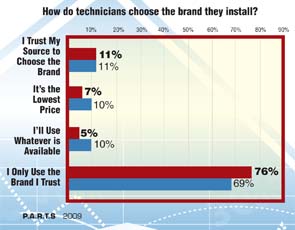On average, four jobs per month require wheel bearings in the shops that responded to Counterman magazine’s most recent P.A.R.T.S. survey. Given that number, only 13 percent of shops say they keep wheel bearings in stock.
Shops that responded to the Counterman P.A.R.T.S. survey say they rely on an average of 2.7 sources for wheel bearings, jobbers being the primary source for more than half of those surveyed. Fifty-seven percent of shops in 2009 called jobbers their primary source, down from 69 percent in 2008. WD direct increased as the second leading choice – rising from 9 percent in 2008 to 14 percent in 2009.
When asked why they rely on their “first call,” 44 percent of respondents selected availability as their top priority, followed by best sales reps (30 percent) and fast delivery (20 percent). Fast delivery and best sales reps both dropped in importance from 2008 to 2009, while availability jumped in importance from 23 percent in 2008 to 44 percent in 2009.

Editor’s Note: In the chart above, the blue bar represents the year 2008 and the red bar represents 2009.
These and other statistics can be found in P.A.R.T.S., produced annually by Counterman magazine. Nine years ago, Counterman began surveying repair shops annually to determine when, how and why they source specific automotive parts and products. The resulting data, published every fall, offers perspective on how sourcing and brand-loyalty trends have changed.












